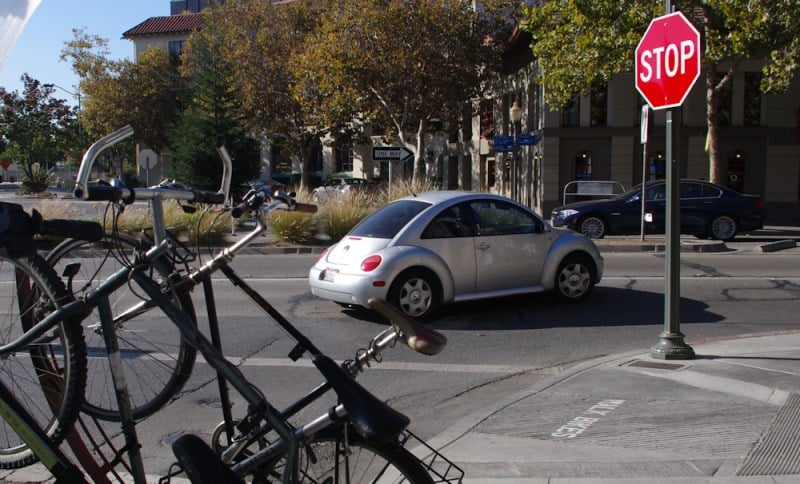Last week Palo Alto residents voted to overturn a city council ruling that would have re-zoned property on Maybell Avenue to allow construction of an affordable senior housing project on the vacant lot.
The Palo Alto Housing Corporation (PAHC)—a private non-profit provider of affordable housing—originally acquired the parcel of land at an auction for nearly $16 million and planned to construct 60 housing units for low-income seniors on Maybell Avenue under the modified zoning. The group now intends to discontinue work on the project and sell the property.
Measure D, as the rezoning referendum was designated, was opposed by Palo Altans to Preserve Neighborhood Zoning, a group that was organized after the City Council voted in August to allow the affordable housing development to proceed.
Cheryl Lilienstein, spokesperson for Palo Altans to Preserve Neighborhood Zoning, said residents felt the City Council was not receptive to their input during its deliberations on the rezoning issue in August.
“The campaign started…because the City Council seemed unwilling to hear the neighborhood’s complaints and concerns about the safety of children on the streets, and about high density development in our neighborhoods that’s just never happened before,” Lilienstein said.
The Santa Clara County Registrar of Voters reported 6,538 voters in favor of rezoning the property and 8,476 votes against.
Lilienstein was enthusiastic about the win.
“We went into election day feeling hopeful and knowing that we were in the ballpark, but having no idea that the outcome was going to be such a wide spread,” she said.
Candice Gonzalez, executive director of PAHC, expressed shock and disappointment over the outcome.
Property to be Sold
According to Gonzalez, the result leaves PAHC with no alternative to selling the property.
“As we said all along, if this measure failed, our only choice would be to sell [the property],” Gonzalez said. “There’s no revised viable project. We proposed what was viable and feasible.”
She explained that the project would not have been possible under existing zoning, since in order to compete for funding, costs would have to be contained.
Because land values are higher in Palo Alto than in many other communities where other housing authorities are competing for the same funding sources, PAHC needed a higher density of units than existing zoning would allow, Gonzalez added.
“You need more units to spread out the fixed costs of the land,” she said. “We proposed the density that was required to make an affordable housing project work here in Palo Alto.”
The need for a larger number of units was intensified by PAHC’s commitment to providing at least 20 units with rents of $500 per month in the proposed development.
“We committed to a minimum of 20 units in the extremely low income level,” Gonzalez said. “We need the balance of the 40 [higher rent] units to make that operationally viable.”
The highest rent in the proposed development would have been $1,100 per month.
“Nothing to do with senior housing”
Lilienstein explained that her group’s opposition to the measure was unrelated to the affordable housing project itself.
“We were very clear when we started this campaign that it had nothing to do with senior housing and everything to do with high density,” Lilienstein said. “Our neighborhood is not opposed to senior housing and hasn’t been.”
Gonzalez offered a similar view of the controversy surrounding Measure D.
“It became about development and traffic and [planned community zoning] in general rather than focusing on this project in particular,” Gonzalez said. “I think many in the opposition wanted to send a message to City Council about development, but they sent that message at the expense of lower-income seniors, at the expense of the less privileged.”
Lilienstien was critical of the proposed development.
“We are opposed to housing seniors in apartments that have no amenities and that are far from services that seniors need, and don’t have enough parking spaces,” she said. “[The proposed project] just didn’t have the quality that we would expect from a development in our neighborhood.”
An Unsolved Problem
The current waiting list for PAHC’s existing affordable senior housing development includes more than 500 names, according to Gonzalez.
“The waiting list is just going to get longer,” Gonzalez said. “It’s going to be harder and harder to serve the low-income seniors, which means that a lot of seniors will be forced out of the city.”
Gonzalez said the current wait to be placed in an existing development is five years or more, and that many seniors pass away before being accommodated.
Lilienstein suggested a bonds measure to support a future affordable housing project for seniors at a different location.
Contact Sam Kurland at kurlands ‘at’ stanford.edu.
